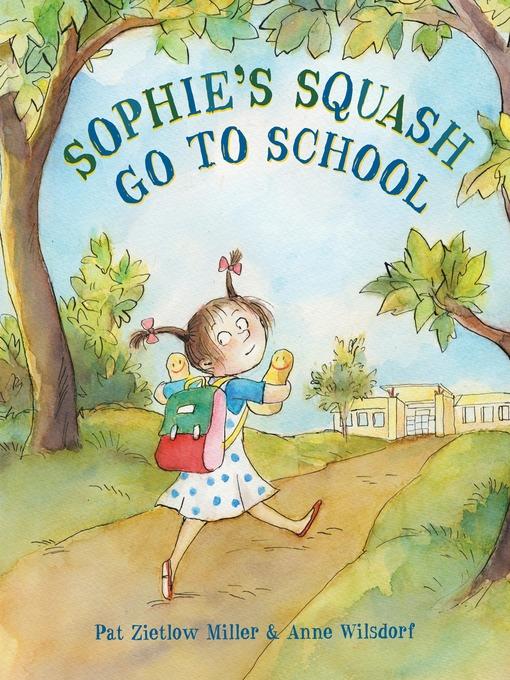
Sophie's Squash Go to School
Sophie's Squash
فرمت کتاب
ebook
تاریخ انتشار
2016
Lexile Score
550
Reading Level
0-2
ATOS
2.5
Interest Level
K-3(LG)
نویسنده
Anne Wilsdorfشابک
9780553509465
کتاب های مرتبط
- اطلاعات
- نقد و بررسی
- دیدگاه کاربران
نقد و بررسی

Starred review from May 9, 2016
As the heroine of Sophie’s Squash (2013) heads to school, Bonnie and Baxter—the butternut squash she befriended at the end of that book—come along. The squashes’ painted-on smiles keep them looking permanently happy, but Sophie is having a rougher time: “The chairs were uncomfortable. The milk tasted funny. And no one appreciated her two best friends.” A cheerful boy named Steven
is the worst offender, as far as Sophie is concerned, and she rebuffs his repeated attempts at friendship. Once again, Wilsdorf adeptly captures Sophie’s every mercurial grimace and scowl, as well as her softening attitudes, both toward school and toward Steven, who Miller gives the patience of a saint. By book’s end, most readers will be willing to side with Sophie’s parents, who remind her that it’s good to have friends: “Especially human ones.” Ages 3–7. Author’s agent: Ammi-Joan Paquette, Erin Murphy Literary. Illustrator’s agency: Studio Goodwin Sturges.

June 1, 2016
A little girl's friendship with the two squash she grew in her garden (Bernice's twin babies from Sophie's Squash, 2013) gets in the way of a friendship with a real child when Sophie starts school.Steven Green, a black boy, won't leave Sophie, a white girl, alone. He sits by her, follows her, and makes all kinds of overtures of friendship. But she rebuffs him, stating that gourds Bonnie and Baxter are all the friends she needs. But readers will catch on pretty quickly that though Sophie seems like one huge bad attitude, with her scowly face, upturned nose, and snootiness, she is beginning to see the value of human friends--she just doesn't know quite how to reach out to them. But "friends" doesn't include Steven, especially after she has to put her squash in their winter bed and Steven accidentally tears Sophie's picture of them. But then Marvin, Steven's stuffed frog, and Sophie's parents help the stubborn girl learn that "sometimes growing a friend just takes time." Wilsdorf's illustrations, done in watercolor and China ink, provide few clues to the question Miller generates in the text: why in the world is an upbeat and happy kid like Steven so intent on being friends with such a contrary girl? Roshni, seemingly South Asian, and Steven are the only two children of color in the class, and Ms. Park, their teacher, is black.Sophie's negativity is a definite turnoff, though Steven and his problem-solving are delightful. (Picture book. 4-8)
COPYRIGHT(2016) Kirkus Reviews, ALL RIGHTS RESERVED.

August 1, 2016
PreS-Gr 1-Who needs a friend when you have a squash? When readers last encountered the stubborn protagonist of Sophie's Squash, the girl's beloved Bernice was becoming freckled with spots and mushy. On the advice of the farmer, Sophie provides Bernice with fresh air, clean soil, and love (the squash gets buried by its favorite outdoor spot). Along with the arrival of the warm weather, a sprout appears, and, ultimately, Bernice's two offspring arrive. Now Sophie is starting school, and with her go the small fruits named Bonnie and Baxter. Once there, the kindergartner encounters and vehemently rebuffs the friendly overtures of the persistent Steven Green (who carries around a frog). Slowly, the classroom activities and outdoor games of her classmates begin to attract Sophie's interest, but it isn't until Bonnie and Baxter are tucked in for their "winter nap" and her teacher's question, "What makes a good friend?," followed by a tussle with Steven, an apology, and a plan, that she realizes that friends come in all forms, including human. Young children will relate to Sophie's unease in a new environment and her difficulty letting go of the familiar and comforting. Wilsdorf's watercolor and ink art, filled with details, depict a colorful classroom complete with art projects, books, blocks, and enough activity (and humor) to tempt the most reluctant of preschoolers to give kindergarten a try. VERDICT A warm and encouraging look at starting school, perfect for reading aloud and small group sharing.-Daryl Grabarek, School Library Journal
Copyright 2016 School Library Journal, LLC Used with permission.

Starred review from May 15, 2016
Preschool-G *Starred Review* Starting school is tense for Sophie, even with her two best friends (squash with smiling faces drawn on them) along for companionship. The other kids don't really understand her doll-like squash, and though her classmate Steven tries to befriend her, she's just not ready. In Sophie's Squash (2013), Sophie discovered that relationships with vegetables are relatively short-lived, so she tentatively considers playing with other children. Soon after tucking the squash into the ground for their winter nap, she listens to a class discussion of what makes a good friend. She ponders those ideas later, and, after a quarrel with Steven, turns to him for friendship and for help with her latest great idea. While in many picture books problems are solved quickly, Miller makes clear that it takes time, as well as reflection and effort, for Sophie to decide that she wants friends and to figure out how to make them. The character is shy, strong-willed, and resistant to change, qualities many children will relate to as they start school. The text features realistic dialogue and well-calibrated narration, while the expressive, colorful ink-and-watercolor pictures capture the child's sometimes-chaotic, multicultural classroom and her shifting emotions with equal finesse. A rewarding picture book for reading aloud.(Reprinted with permission of Booklist, copyright 2016, American Library Association.)

























دیدگاه کاربران